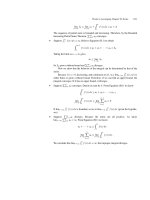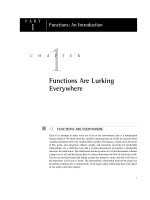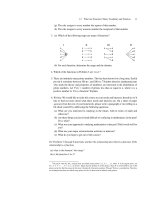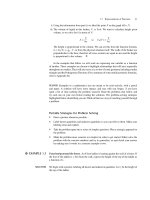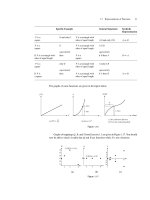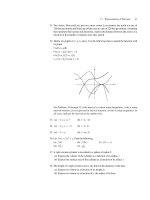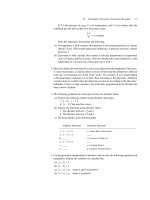Calculus: An Integrated Approach to Functions and their Rates of Change, Preliminary Edition Part 116 pdf
Bạn đang xem bản rút gọn của tài liệu. Xem và tải ngay bản đầy đủ của tài liệu tại đây (165.03 KB, 10 trang )
Proofs to Accompany Chapter 30, Series 1131
lim
n→∞
S
n
≤ lim
n→∞
a
1
+
n
1
f(x)dx =a
1
+A
The sequence of partial sums is bounded and increasing. Therefore, by the Bounded
Increasing Partial Sums Theorem,
∞
k=1
a
k
converges.
Suppose
∞
1
f(x)dx =∞.Refer to Equation (H.1) to obtain
n−1
1
f(x)dx ≤a
1
+a
2
+···+a
n
=S
n
Taking the limit as n →∞gives
∞≤ lim
n→∞
S
n
.
So S
n
grows without bound and
∞
k=1
a
k
diverges.
Now we show that the behavior of the integral can be determined by that of the
series.
Because f(x)>0,decreasing, and continuous on [1, ∞), lim
b→∞
b
1
f(x)dx is
either finite or grows without bound. Therefore, if we can find an upper bound, the
integral converges. If it has no upper bound, it diverges.
Suppose
∞
k=1
a
k
converges. Denote its sum by S. From Equation (H.1) we know
n
1
f(x)dx ≤a
1
+a
2
+···+a
n−1
lim
n→∞
n
1
f(x)dx ≤ lim
n→∞
n−1
k=1
a
k
= S.
If lim
n→∞
n
1
f(x)dx is bounded, so too is lim
b→∞
b
1
f(x)dx (given the hypothe-
ses).
Suppose
∞
k=1
a
k
diverges. Because the terms are all positive, we know
lim
n→∞
n
k=1
a
k
=∞.From Equation (H.1) we know
a
2
+···+a
n
≤
n
1
f(x)dx
lim
n→∞
n
k=2
a
k
≤ lim
n→∞
n
1
f(x)dx.
Weconclude that lim
b→∞
b
1
f(x)dx =∞;the improper integral diverges.
Index
Abel, Niels, 382, 1078n
Absolute convergence
conditional, 953
explanation of, 952–953
implies convergence, 1128–1129
Absolute maximum point, 347
Absolute maximum value, 252, 347
Absolute minimum point, 347
Absolute minimum value, 347, 352
Absolute value function
explanation of, 61–62
maximum and minimum and, 350
Absolute values
analytic principle for working with, 66
elements of, 65
functions and, 129
geometric principle for working with,
66–68
Acceleration
due to force of gravity, 150n, 406–407
explanation of, 76
Accruement, 746
Accumulation, 746
Addition
of functions, 101–103
principles of, 1059–1061
Addition formulas, 668–669, 709
Additive integrand property, 738
Algebra
equations and, 1053
explanation of, 1051–1052
exponential, 247, 309–312
exponents and, 1053–1054
expressions and, 1052–1053, 1056–1070
order of operations and, 1054
solving equations using, 1071–1083 (See
also Equations)
square roots and, 1054–1055
Alternating series
error estimate, 954–955
explanation of, 953
Alternating series test, 953–956, 977
Amount added, 746
Amplitude
definition of, 603
modifications to, 604, 606
Ancient Egyptians, 95, 97n, 627, 854
Angles
complementary, 630
of depression, 631
of elevation, 631
initial side of, 619
measurement of, 619–622
right, 620
terminal side of, 619–620
trigonometric functions of, 622–623
vertex of, 619
Antiderivatives
definition of, 761, 762
for integrand, 805–806
list of basic, 783–786
table of, 789–790
use of, 763, 764, 766, 770, 771
Antidifferentiate, 805
Approximations
constant, 920
of definite integrals, 805–816, 820–825
Euler’s method and, 1022
examples of, 828–829
higher degree, 923–924
linear, 159, 163
local linearity and, 279–282
net change, 715–718
Newton’s method, 1121–1125
polynomial, 693–694, 919–931
second degree, 921–922
successive, 170, 176, 208, 715–718
tangent line, 282–284, 920–921, 937
Taylor polynomial, 924–931
third degree, 922–923
Arbitrarily close, 249
Arbitrarily small, 249, 250
Arccosine, 646, 647
Archimedes, 97n, 245, 1079n
Arc length
definite integrals and, 865–867
definition of, 594, 708
explanation of, 621–622
Arcsine, 646, 647
Arctangent, 646
Area
of circle, 17
of oblique angles, 662–663
of oblique triangles, 662–664
slicing to find, 843–845
Area function
amount added, accumulation,
accruement and, 745
characteristics of, 747–755
definition of, 745
explanation of, 743–744
general principles of, 744–745
Astronomy, 1107
Asymptotes
horizontal, 64–65, 407–409, 411
overview of, 64–65
vertical, 64, 407, 408, 617
Autonomous differential equations
explanation of, 997
qualitative analysis of solutions to,
1002–1014
Average rate of change
calculation of, 170
definition of, 75
explanation of, 73–76, 176
Average value
definition of, 777
of functions, 775–780
Average velocity
to approximate instantaneous velocity,
208
calculation of, 171–176
explanation of, 171
over time interval, 76, 77
Avogadro’s number, 150n
1133
1134 Index
Babylonians, 95, 97n, 620
Bacterial growth, 306, 324–325
Balance line, 603, 604
Balance value
change in, 606
definition of, 603
explanation of, 604
Base, 1053
Benchmark, 53
Bernoulli, Johann, 17n
Bessel, Freidrich, 961
Bessel function, 961, 976
Bhaskara, 95
Binomial series
explanation of, 946–947
use of, 948–949
Bottle calibration, 4, 20–21, 29n, 32,
209–210
Bounded Increasing Partial Sums Theorem,
965, 966, 1131
Bounded Monotonic Convergence
Theorem, 965
Boyle, Robert, 546n
Boyle’sLaw,546n
Braces, 18n
Brahe, Tycho, 1107
Briggs, Henry, 447
Calculators. See also Graphing calculators
irrational numbers and, 96, 97
limits and, 267–269
logarithms using, 440–443, 450
order of operations on, 1054
roots on, 1058
trigonometric functions on, 605n, 608,
647, 919
use of graphing, 87–89
Calculus
differential, 111n, 806
Fundamental Theorem of, 757–758,
761–771 (See also Fundamental
Theorem of Calculus)
historical background of, 211, 245
integral, 806
Calibration, bottle, 4, 20–21, 29n, 32,
210–211
Cardano, Girolamo, 95, 382
Carrying capacity, 150n, 1008–1010
Cellular biology, 984
Chain Rule
application of, 517–519, 523–527,
539–543, 551, 785, 805, 1028
definition of, 517, 709
derivatives and, 521–522, 692, 706
interpretation of, 517
in reverse, 787–796
substitution to reverse, 792–794
Charles, Jacques, 546n
Charles’sLaw,546n
Circle
area of, 17
explanation of, 1100, 1102
illustration of, 1099
symmetry of unit, 623–624
Circumference formula, 17n
Closed form of sum, 564
Closed intervals, 18
Coefficients
differential equations with constant,
1045–1049
explanation of, 1053
leading, 379, 1063
of the xk term, 380
Cofunction identity, 669
Common log of x, 442
Comparison Tests, 969–972, 977
Comparison Theorem, 912
Complementary angles, 630
Completeness Axiom, 965n
Completing the square, 231–232, 1075
Composite functions
Chain Rule to differentiate, 788
derivatives of, 513–517, 521–527
Composition, of functions, 108–113
Concave down, 52, 195
Concave up, 51, 52, 195
Concavity
cubic and, 376
second derivative and, 356–358
Conditional convergence, 953
Conic sections
astronomy and, 1107
degenerate, 1099
from geometric viewpoint, 1100–1101
overview of, 1099–1100
reflective properties of, 1106–1107
relating geometric and algebraic
representations of, 1102–1105
Conjecture, 335
Constant factor property, 738
Constant function, 8
Constant Multiple Rule, 291–292
Constant of proportionality, 306n
Constant rate of change
calculating net change in case of,
712–714
linear functions and, 143–144, 169
Constant solutions. See Equilibrium
solutions
Continuity
definition of, 270, 273
Extreme Value Theorem and, 271
Intermediate Value Theorem and, 271
Sandwich Theorem and, 272–273
Continuous functions
average value of, 775–776
of closed interval, 352
explanation of, 54–55
invertible, 426
Convergence
absolute, 952–953, 1128–1129
alternating series and, 954–956
conditional, 953
explanation of, 566, 568, 569, 904
improper integrals and, 904–907
in infinite series, 574
of Maclaurin series, 944
of power series, 945–946, 956, 1129
radius of, 945, 956–958
of Taylor series, 944n, 947
Convergence tests
basic principles of, 964–965
Comparison Test and, 969–971
Integral Test and, 965–969, 972
Limit Comparison Test and, 971–972
Ratio and Root tests and, 972–976
summary of, 977
transition to, 962
use of, 975
Convergence Theorem for Power Series,
1129
Converse, 30n
Cosecant, 629
Cosine functions. See also Trigonometric
functions
definition of, 594
domain and range of, 598
graphs of, 597–598, 603–609
symmetry properties of, 598–599
Cosines, Law of, 658–662, 709
Cotangent, 629
Coterminal angles, 620
Critical points
concavity and, 356–358
of cubics, 375–376
extreme values and, 349–353
of polynomials, 386–387
Cubic formula, 382
Cubics
characteristics of, 375–377
explanation of, 373
function as, 373–377
roots of, 381–382
Simpson’s Rule applied to, 823
Curves
calculating slope of, 169–177
slicing to find area between, 843–845
solution, 501–503
Decomposition
of functions, 119–121
into partial fractions, 898–901
Definite integrals
arc length and, 865–867
area between curves and, 843–850
average value of function and, 775–780
definition of, 728
Index 1135
evaluation of, 763
explanation of, 725–727
finding exact area and, 727–729
finding mass when density varies and,
827–838
fluid pressure and, 871–874
Fundamental Theorem of Calculus used
to compute, 770
integration by parts and, 882–883
interpretations of, 729, 743
numerical methods of approximating,
805–816, 820–825
properties of, 738–741
qualitative analysis and signed area and,
731–736
substitution in, 794–796
work and, 867–871
Definitions, 3
Degrees
of angles, 620
radians vs., 685
Demand function, 104
Density, 827–838
Dependent variables, 5
Derivatives
of bx, 473–475
calculation of, 190–192
of composite functions, 513–517,
521–527
Constant Multiple Rule and, 290–293
of cubic, 374–375
definition of, 187
explanation of, 188–190, 481, 523
of exponential functions, 334–338
historical background of, 211
instantaneous rate of change and,
209–211, 711, 983
of inverse trigonometric functions,
703–706
limit definition of, 190, 191
local linearity and, 279–284
of logarithmic functions, 467–471
meaning and notation and, 208–209
modeling using, 288–289
Product Rule and, 292–295
properties of, 273, 291–292
of quadratics, 219–221
qualitative interpretation of, 194–201
Quotient Rule and, 297–298
second, 221, 288–289, 356–358
of sums, 290–292
theoretical basis of applications of,
1087–1093
as tool for adjustment, 282
of trigonometric functions, 683–685, 708
working with limits and, 272
of xn for n, 295–297
Derivative tests
first, 351, 358
second, 357, 358
Descartes, Rene, 61
Differential calculus, 111n, 806
Differential equations
applications for, 984–988
autonomous, 997
with constant coefficients, 1045–1049
definition of, 498
explanation of, 498–500
first order, 988, 1018–1022
homogeneous, 1045–1049
modeling with, 503–506, 983–990
nonseparable, 1022
obtaining information from, 988–990
population growth and, 503–506, 984
power series and, 959–961
qualitative analysis of solutions to
autonomous, 1002–1014
radioactive decay and, 503, 504
second order, 988, 1045–1049
separable, 1018–1022, 1030
solutions to, 498–503, 988, 991–997,
1002–1014, 1018–1022
systems of, 1024–1040
Differentiation
of composite functions, 513–517
examples of, 535–538
flawed approaches to, 536
implicit, 541–554 (See also Implicit
differentiation)
logarithmic, 538–541
of logarithmic functions and exponential
functions, 476–481
polynomials and, 385, 386
of power series, 956–959
Product Rule and, 292–294
of trigonometric functions, 683–698,
703–706
Differentiation formulas, 523–524
Direct Comparison Test, 969
Directrix, 1100, 1101
Dirichlet, Lejeune, 17n
Discontinuities
points of, 407–410
removable and nonremovable, 407
Discontinuous functions, 54–55
Distributive Law, 1056, 1065
Divergence
explanation of, 566, 568, 904
of harmonic series, 953
improper integrals and, 904–907
in infinite series, 574
nth Term Test for, 574, 964, 977
Division
of fractions, 1061–1063
of functions, 103–105
of polynomials, 382–383
by zero, 1053
Domain
of function, 5
natural, 17
of trigonometric functions, 598
Dominance property, 738
Double-angle formula, 669, 709
Double root, 380
Dummy variables, 784
Einstein’s theory of special relativity, 938
Ellipses
explanation of, 1100–1103
illustration of, 1099
reflecting properties of, 1106
Endpoint reversal property, 738, 744
Epidemic models, 1024–1025, 1034–1038
Epidemiology, 986, 1024–1025, 1034–1038
Equal Derivatives Theorem, 1088,
1092–1093
Equations. See also Differential equations
explanation of, 1053
exponentiation to solve, 449–455
expressions vs., 537–538
fitted to sinusoidal graph, 606–607
fundamental principle for working with,
1053
growth, 306
higher degree, 1078–1080
linear, 159, 1071–1073
of lines, 144–145, 148–150
logarithms to solve, 449–457
quadratic, 1073–1078
with radicals, 1081–1083
solutions to, 1071–1083
trigonometric, 651–655
Equilibrium, stable, 106–108
Equilibrium solutions
definition of, 1004
example of, 1004–1005
explanation of, 989
stability and, 1006–1008
Erd
¨
os, Paul, 688n
Error bounds, 823–825
Euler, Leonhard, 17n, 492n
Euler’s Formula, 1048
Euler’s method, 1022
Even functions, 65
Existence and Uniqueness Theorem, 994
Exponential algebra
application of, 247, 309
basics of, 309–312
Exponential functions
derivative of, 334–338
explanation of, 312–314, 497
food decay and, 303, 326–327
generalized power functions and, 524
graphs of, 462–463
growth of money in bank account and,
303, 320–322, 325, 503
1136 Index
Exponential functions (continued)
laws of logarithmic and, 444–447
manipulation of, 314–316
modeling with, 559
radioactive decay and, 322–324
writing and rewriting, 324–326
Exponential growth
examples of, 306–307
explanation of, 303–306
Exponentiation, 449–455
Exponent Laws, 1058
explanation of, 309, 310
list of, 481
Exponents
explanation of, 1053–1054
multiplication and working with,
1057–1059
Expressions
addition and subtraction, 1059–1061
division and complex fractions,
1061–1063
equations vs., 537–538
explanation of, 1052–1053
factoring, 1064–1070
multiplying and factoring, 1056–1057
multiplying and working with exponents,
1057–1059
terminology and, 1063–1064
working with, 1056–1070
Extraneous roots, 1082
Extrema
analysis of, 346–348
definition of, 347
global, 351–354
local, 351, 353, 391–392
Extreme, absolute, 353
Extreme Value Theorem
continuity and, 271
explanation of, 349, 352, 1087, 1089,
1090
Factorial notation, 694
Factoring
difference of perfect squares, 1068–1069
explanation of, 1056–1057
out common factor, 1065–1066
quadratics, 1066–1068
use of, 1064–1065, 1069–1070
Finite geometric sum, 561, 563
First derivative, 288–289
First derivative test, 351, 358
First order differential equations
explanation of, 988
solutions to separable, 1018–1022, 1030
Fixed costs, 102, 103
Flipping, 126–129
Fluid pressure, 871–874
Focus, 1100
fog, 108
Folium of Descartes, 543, 544
Food decay, 303, 326–327
Foot-pound, 868
Fractions
adding and subtracting, 1059–1061
complex, 1061–1063
division of, 1061–1063
historical background of, 95
integration using partial, 898–901
multiplication of, 1057
simplification of, 1057
Free fall, 237–240
Functional notation
examples of, 9–10, 17
explanation of, 8–9
Functions. See also specific types of
functions
absolute value and, 66–68, 350
addition and subtraction of, 101–103
altered, 126–131
area, 743–755
asymptotes and, 64–65
average value of, 775–780
Bessel, 961, 976
composite, 513–517, 519–525
composition of, 108–113
constant, 8
continuous/discontinuous, 54–57, 352,
426
decomposition of, 119–121
definition of, 5
derivatives as, 187–211 (See also
Derivatives)
domain and range of, 5, 17–21
equality of, 17
even, 65
examples of, 61–64
explanation of, 2–3, 5–9
exponential, 303, 312–328
to fit parabolic graph, 233–235
graphs of (See Graphs)
increasing/decreasing features of, 51–54
inverse, 32, 110, 421–426, 429–432, 434
invertible, 423–426, 429–434, 440
linear, 143–151
locally linear, 142
logarithmic, 439–457, 462–466 (See
also Logarithmic functions)
as machine, 6–7
as mapping, 6–8
of more than one variable, 33
multiplication and division of, 103–105
names of, 5
odd, 65
overview of, 1–2
portable strategies for problem solving
and, 21–28
positive/negative features of, 49–51
quadratic, 217–240
rational, 407–417
reciprocal, 62, 130–131
representations of, 15–17
sinusoidal, 603–604
solution to differential equation as, 988
Fundamental Theorem of Calculus
definite integrals and, 761–763
explanation of, 757–758, 770–771
power of, 762, 767–770
use of, 763–767, 1097
Galois,
´
Evariste, 1078n
Galois theory, 1078n
Generalized power functions, 524
Generalized power rule, 524
Generalized Ratio Test, 975–976
General solutions, 500–502, 996
Geometric formulas, 17n, 1086
Geometric series
applications of, 579–586
to compute finite geometric sums, 570
convergence and, 977
definition of, 566
explanation of, 566–570, 962, 964
Geometric sums
applications of, 579–586
examples of, 563–564
finite, 561, 563
geometric series to compute finite, 570
introductory example of, 559–563
Global extrema, 351–354
Global maximum point, 347
Global maximum value, 347, 352
Global minimum point, 347
Global minimum value, 347, 352
Graphing calculators. See also Calculators
Taylor polynomials on, 937
trigonometric functions on, 605n, 608
use of, 87–89, 382
Graphs
of derivative functions, 196–201
of functions, 28–33, 62, 63, 65, 84,
87–89
of invertable functions, 425–426
of linear functions, 144–147
of logarithmic functions, 462–466
of periodic functions, 596
of polynomials, 384–385, 391–399
position, 84–85
of quadratics, 219, 221, 223, 231–235
rate, 85–87
of rational functions, 410–417
of reciprocal functions, 130–131
of squaring functions, 63
tips for reading, 85, 87
of trigonometric functions, 597–598,
603–609, 616–618, 647, 708
Gravitational attraction, 406
Gregorian calendar, 53n
Index 1137
Guy-Lussac, Joseph, 546n
Guy-Lussac’sLaw,546n
Happiness index, 51
Height, 77
Herodotus, 95n
Higher degree equations, 1078–1080
Hindus, 95n
Hipparchus, 627
Hooke’s Law, 1045
Horizontal asymptotes
explanation of, 64–65
rational functions and, 407–409, 411
Horizontal line test, 33, 426
Horizontal shift, 607–608, 669
Hypatia, 95n
Hyperbolas
explanation of, 1103
illustration of, 1099
reflective properties of, 1107
Hypotenuse, 628
Identity function, 61
Implicit differentiation
explanation of, 541–545
particular variables and, 546–548
process of, 545–546
related rates of change and, 550–554
Improper integrals
explanation of, 903
infinite interval of integration and,
903–907
method of comparison and, 912–914
methods to approach, 908–912
unbounded and discontinuous integrands
and, 907–908
use of, 903
Increasing and Bounded Partial Sums Test,
574
Increasing/Decreasing Theorem, 1088
Indefinite integrals
definition of, 783
using integration by parts, 878–882
Independent variables, 5
Indeterminate forms, 490n
Induction, 296, 1095–1097
Induction hypothesis, 296
Inequalities, Intermediate Value Theorem
and, 55–56
Infinite series
definition of, 566
general discussion of, 572–574
geometric, 566–570
Inflation, 487
Inflection point, 357, 376
Initial condition, 502
Initial conditions, 501–503
Instantaneous rate of change
calculation of, 170–178, 208
derivative and, 209–211, 711, 983
explanation of, 170, 176, 523
velocity and, 170, 173
Instantaneous velocity
average velocity to approximate, 208
explanation of, 170, 173–174
limit and, 245–246
Integers, 1063
Integral calculus, 806
Integrals
definite (See Definite integrals)
improper, 903–914
indefinite, 783–785, 878–882
substitution to alter form of, 798–802
trigonometric, 886–890
Integral Test
for convergence of series, 1129–1131
explanation of, 965–968, 977
proof of, 968
use of, 968–969, 972
Integrands
antiderivative of, 805–806
definition of, 783
explanation of, 729, 770
expressed as sum, 798
unbounded and discontinuous, 907–908
Integration
infinite interval of, 903–907
of power series, 956–959
solving differential equations by, 995
Integration by parts. See also Product Rule
definite integrals and, 882–883
explanation of, 877–878
formula for, 878, 879, 882
indefinite integrals and, 878–879
repeated use of, 879–882
use of, 805, 846n
Interest rates, 487–489, 494–495, 579–586
Intermediate Value Theorem
continuity and, 271
explanation of, 55
inequalities and, 55–56
Interval notation, 18–19
Interval of convergence
explanation of, 945–946
Taylor series and, 944n, 947
Intervals
closed, 18
increase and decrease on, 51–54
open, 18, 270
Inverse functions
arriving at expression for, 429–432
definition of, 423
explanation of, 32, 110, 421–426, 440
graphs and, 425
horizontal line test and, 426
interpreting meaning of, 434
slicing and, 846–850
Inverse sine, 646
Inverse trigonometric functions
derivatives of, 703–706
explanation of, 645–649, 708
Irrational numbers, 1063–1064
definition of, 87
historical background of, 95, 96
nature of, 88–89, 96–99
proof of, 88n
working with, 247
Isosceles triangles, 635n
Joule, 868
Julian calendar, 53n
Kepler, Johannes, 447, 1107
Kepler’s Laws, 961
al-Khowarizmi, 95
Kinetic energy, 938
Lagrange, Joseph, 211
Lambert, Johann, 97
Law of Cooling (Newton), 326, 985–986,
1002–1004, 1025–1028
Law of Cosines
explanation of, 658–659, 709
proof of, 660–661
use of, 661–662
Law of Sines
explanation of, 659–660, 709
proof of, 664
use of, 664–665
Leading coefficients, 379
Least common denominator (LCD), 1059,
1060
Left- and right-hand sums
explanation of, 727, 728, 820
limits and, 258–262, 270, 728
net change and, 718–722
use of, 806–808, 812–815
Legs, 628
Leibniz, Gottfried Wilhelm, 209, 211, 245,
292n, 953
Leibniz’s notation, 209, 211, 221
Lemmas, 688n
L’H
ˆ
opital’s Rule
definition of, 1112
proof of, 1114–1116
use of, 490n, 1112–1114, 1117, 1118
Limit Comparison Test, 971–972, 977
Limit principle, 490, 492n, 493n
Limits
application of, 245–246
approaches to, 265–269
computation of, 251–255, 489–491
definition of, 250–255, 524
explanation of, 246–250
function of, 491–495
left- and right-handed, 258–262, 270
one-sided, 259–260
1138 Index
Limits (continued)
principles for working with, 272–273
trigonometric functions and, 688–691
two-sided, 262
Linear approximations, 159, 163–164
Linear equations
definition of, 1071
simultaneous, 159
solutions to, 1071–1073
Linear functions
characteristics of, 143–144
definition of, 144
explanation of, 373
graphs of, 144–147
piecewise, 159, 161
zero of, 381
Linearity
differential calculus and local, 111n
intuitive approach to local, 142–143
Linear models, 159–164
Lines
equations of, 144–145, 148–150
graphs of, 147
parallel, 148
perpendicular, 148
point-slope form of, 149
secant, 75
slope-intercept form of, 149
slope of, 145–150
vertical, 147–148
Lithotripsy, 1106–1107
Liu Hui, 95
Local extrema, 351, 353, 391–392
Local Extremum Theorem, 1087–1090
Local linearity
derivatives and, 279–284
differential calculus and, 111n
explanation of, 142–143, 1114
use of, 143
Local maximum point, 347
Local maximum value, 347, 354
Local minimum point, 347
Local minimum value, 347, 354
Logarithmic differentiation
definition of, 538
to find y
1
, 538–539
use of, 539–540
Logarithmic functions
definition of, 440, 442
derivative of, 467–475
explanation of, 440–443
graphs of, 462–466
historical background of, 447
introductory example of, 439–440
laws of exponential and, 444–447
Logarithmic laws, 445, 481
Logarithms
calculator use and, 440–443, 450
converted from one base to another,
450–454
definition of, 441–442
differentiation and, 476–480
properties of, 444–448
solving equations using, 449–457
summary of, 480–481
uses for, 447–448
Logistic growth model, 898, 1009,
1019–1020, 1024
Long division, 382–383
Lower bound, 716, 717
MacLaurin, Colin, 920
Maclaurin series
alternation series and, 953
binomial series and, 946, 947
convergence and, 944
explanation of, 941, 948
procedure for finding, 941–942, 957, 961
Marginal cost, 210
Mass, 827–838
Mathematical induction, 296, 1095–1097
Mathematical models, 2
Mayans, 95n
Mean Value Theorem, 346, 866n, 1087,
1090–1093
Midpoint sum, 807–811, 813–815
Modeling
with derivatives, 288–289
with differential equations, 503–506,
983–990
of population interactions, 1038–1040
Money, growth of, 303, 320–322, 325
Multiplication
with exponents, 1057–1059
with expressions, 1056–1057
with fractions, 1057
with functions, 103–105
Napier, John, 447
Natural domain, 17
Natural log of x, 442
Negative numbers, 95
Net change
with constant rate of change, 712–714
difference between left- and right-hand
sums and, 718–722
explanation of, 712
with nonconstant rate of change,
715–718
overview of, 711–712
Newton, 868
Newton, Isaac, 211, 245, 1107
Newtonian physics, 938–939
Newton-meter, 868
Newton’s Law of Cooling, 326, 985–986,
1002–1004, 1025–1028
Newton’s method
applications for, 1124–1125
for approximating root of f, 1123–1124
explanation of, 1121–1122
use of, 1122–1123
Newton’s Second Law, 868, 1034
Nonremovable discontinuities, 407
Nonseparable first order differential
equations, 1022
Notation
factorial, 694
functional, 8–10, 17
interval, 18–19
summation, 575–577, 769
nth partial sum, 566
nth Term Test for Divergence, 574, 964,
977
Nullclines, 1030–1032, 1035
Number line, 18
Numbers
irrational, 87, 88, 96–99
rational, 87, 95, 96
real, 87, 88
Oblique triangles
area of, 663–664
explanation of, 657
Law of Cosines and Law of Sines and,
658
Obtuse angles, 662–663
Odd functions, 65
Open interval, 18, 270
Operator notation, 209
Optimization
analysis of extrema and, 341–348
application of, 361–364
concavity and second derivative and,
356–358
extrema of f and, 348–354
overview of, 341
Order, of differential equations, 988
Order of operations, 1054
Parabolas
definition of, 219
with derivatives, 220–221
explanation of, 1100, 1101
graphs of, 231–235, 342–343
illustration of, 1099
reflecting properties of, 1106
turning point of, 221
vertex of, 221, 223–225
Parabolic arc, 1107
Parabolic graphs, 233–235
Parallel lines, 148
Parameter, 126n
Partial fraction decomposition, 898–901
Partial sums, 964–966
Particular solutions, 498, 501, 502
Index 1139
Perfect squares
equations with, 1075
factoring difference of, 1068–1069
Period, 603, 604
Periodic functions, 596
Periodicity-based identity, 669
Periodicity-reducing identity, 669
Perpendicular lines, 148
Piecewise linear function, 161
Points, 347
Point-slope form of lines, 149
Polynomial approximations
explanation of, 919–920
of sin x around x = 0, 920–924
Taylor, 924–931
of trigonometric functions, 693–694
Polynomials
characteristics of and differentiation of,
383–387
critical points of, 386–387
cubics and, 373–377
degree of, 380, 1063
of even and odd degrees, 385
explanation of, 373, 379–380, 385–386,
1063
graphs of, 384–385, 391–399
long division of, 383
overview of, 373
zeros of, 380–383, 391
Population growth
differential equations and, 503–506, 984
growth equations and, 306
instantaneous rate of change and, 210
logistic, 1008–1011, 1019–1020, 1024
Population interactions, 1038–1040
Position versus time, 210
Positive integers, 295–297, 1063
Power-reducing formula, 669
Power series
convergence and, 945–946, 956, 1129
definition of, 945
differential equations and, 959–961
differentiation and integration of,
956–959
manipulating, 956
Uniqueness Theorem and, 945
Predictions, 139–143
Present value, 582–585
Probability density function, 903
Production cost versus amount produced,
210
Product Rule. See also Integration by parts
differentiating f(x)· g(x), 292–294
explanation of, 294
proof of, 295
use of, 297, 513, 543, 548, 692, 805
Proof by induction, 1095–1097
Proportionality
constant of, 306n
direct, 16
explanation of, 306
Ptolemy, 95n, 627
Pythagoras, 95, 97
Pythagorean identities
explanation of, 599, 669, 709
trigonometric identities and, 886, 887
use of, 668
Pythagoreans, 89, 95–97
Pythagorean Theorem
historical background of, 95
Law of Cosines and, 658
use of, 554, 599, 631, 635, 637, 672
Quadratic equations
explanation of, 1073–1077
factoring, 1077–1078
Quadratic formula, 1074, 1076–1077, 1080
Quadratics
calculus perspective to, 217–221
definition of, 219
disguised, 1080–1081
examples of, 217–219
explanation of, 373
factoring, 1066–1068
free fall and, 237–240
graphs of, 219, 221, 223, 231–235
noncalculus perspective to, 223–225
overview of, 217
use of quadratic formula to solve,
1076–1077
zero of, 381
Qualitative analysis, 1002–1014
Quotient Rule
application of, 337, 522, 692, 1115
explanation of, 297–298
Radians
converted to degrees, 621
converting degrees to, 621
definition of, 620
degrees vs., 685
Radicals, 1081–1083
Radioactive decay
differential equations and, 503, 504
rate of, 322–324
Radio waves, 605n
Radius of convergence, 945
Range
of functions, 5, 17–21
of trigonometric functions, 598
Rate of change
average, 73–76, 170, 176
constant, 143–144, 169, 712–714
decomposition to find, 121
implicit differentiation and, 550–554
instantaneous, 170–178, 209–211, 523,
711, 983
interpreting slope as, 153
nonconstant, 715–718
predictions and, 140–142
of quadratics, 219
Rational functions
asymptotes and, 407–409
decomposition of, 898–900
discontinuity and, 407–410
explanation of, 406–407
graphs of, 410–417
Rational numbers, 1063
definition of, 87
historical background of, 95, 96
Ratio Test, 973–974, 977
Real numbers, 87, 1063
Real number system
historical background of, 95–96
irrationality and, 96–99
Reciprocal functions
explanation of, 62
graphs of, 130–131
Reduction formula
derivation of, 880–882, 888
use of, 888–890
Relation, 988n
Relative maximum point, 347
Relative minimum point, 347
Removable discontinuities, 407
Revolution, 856–862
Richter scale for earthquakes, 448
Riemann, Bernhard, 727, 955
Riemann sums
explanation of, 727–729
limit of, 728n, 831, 1097
to obtain approximations of definite
integrals, 806
use of, 828, 830, 832, 866
Right angles, 620
Right triangles
applications for, 627–628
definitions of, 628–630, 707
45
◦
,45
◦
,635–637
30
◦
,60
◦
,637–643
trigonometry of, 631–633
Rolle, Michel, 1089n
Rolle’s Theorem, 1087, 1089–1091, 1127,
1128
Roots of multiplicity, 380
Root Test, 975, 977
Sandwich Theorem, 272–273, 757, 944
Secant, 629
Secant line, 75, 208
Second derivative, 221
Second derivative test, 357, 358
Second order differential equations
with constant coefficients, 1045–1049
explanation of, 988
Separable differential equations, 1018–
1022
1140 Index
Sequences, 964, 965, 1129–1131
Series
absolute and conditional convergence
and, 952–953
alternating, 953–956
binomial, 946–949
convergence tests and, 962, 964–977,
1129–1131
geometric, 566–570, 579–586, 962, 964
Maclaurin, 941–942, 944, 946–948, 953,
957, 961
power, 945–946, 956–961
Taylor, 941–944, 947–949, 962
Shifting, 126–129
Shrinking, 126–129
Signed area, 727, 732
Similar triangles, 628
Simple root, 380
Simpson’s Rule
explanation of, 820–821
requirements for, 822–823
use of, 821–823
Sine functions. See also Trigonometric
functions
definition of, 594
domain and range of, 598
graphs of, 597–598, 603–609
symmetry properties of, 598–599
Sines, Law of, 659–660, 664–665, 709
Singh, Jai, 627
Sinusoidal functions, 603–604
Sinusoidal graphs, 606–607
Slicing
to find area between two curves, 843–845
to find mass when density varies,
827–838
to find volume, 853–856
to help with definite integrals, 846–850
Slope
of f
, 194–196
of line, 145–150
modeling and interpreting, 153–155
of tangent line, 208, 684
Slope function
explanation of, 161
of f(x),188, 189
Slope-intercept form of lines, 149
Solution curves
examples of, 1005, 1006, 1010, 1027
explanation of, 501–503
Solutions
to differential equations, 498–503, 988,
991–997, 1002–1014
equilibrium, 989, 1004–1008
to trigonometric equations, 651–655
Soper, H. E., 1037
Splitting interval property, 738
Square roots, 1054–1055
Squaring function
explanation of, 61
graph of, 63
Squeeze Theorem, 272, 757
Stable equilibrium, 106–108
Standard position, 620
Stationary points, 350
Stifel, Michael, 96
Stretching, 126–129
Substitution
to alter form of integral, 798–802
in definite integrals, 794–796
explanation of, 787
mechanics of, 790–791
Taylor series and, 947–949
trigonometric, 890–894
used to reverse Chain Rule, 792–794
Subtraction
of functions, 101–103
principles of, 1059–1061
Subtraction formulas, 668–669
Successive approximations, 715–718
Summation notation
examples of, 576–577
explanation of, 575–576
use of, 769
Sum Rule, 291, 292
Symmetry
even and odd, 65, 386–387
polynomials and, 386–387
of trigonometric functions, 598–599,
623–624
Symmetry-based identity, 669
Symmetry property, 738
Tangent functions
definition of, 615
geometric interpretation of, 615
graph of, 615–618
period of, 616
Tangent line
to f at x = a, 176
slope of, 208, 684
Tangent line approximations, 282–284,
920–921, 937
Tartaglia, Niccolo Fontana, 95, 382
Taylor, Brook, 694, 920
Taylor expansions, 947
Taylor polynomials
centered at x = 0, 925–928, 936, 948
centered at x = b, 928–931, 934, 941
definition of, 925
examples of, 935–939
Taylor remainders, 934–935, 942
Taylor series
convergence and, 944n, 947, 949
explanation of, 941–944
obtaining new, 947–949
substitution and, 947–949
Taylor’s Inequality, 935
Taylor’s Theorem
convergence and, 962
definition of, 935
proof of, 1127–1128
use of, 934–935, 937, 942
Temperature change, 73–74
Theon of Alexandria, 95n
Theorem on Differentiation of Power
Series, 956, 959
Total cost function, 102, 105, 406
Trajectories, 1027–1036
Trapezoidal sums
explanation of, 808
use of, 812–815, 820
Triangles
historical background of, 627
oblique, 657
perspective on, 627–628
similar, 628
solving, 631
trigonometry of general, 657–665
trigonometry of right, 627–633, 635–643
(See also Right triangles)
Trigonometric equations
explanation of, 651
solutions to, 651–655
Trigonometric functions. See also specific
functions
of angles, 622–723
on calculators, 605n, 608, 647
definitions of, 594
differentiation of, 683–698, 703–706
domain and range of, 598
f(x)=tan x, 615–618
graphs of, 597–598, 603–609, 616–618,
647, 708
inverse, 645–649, 703–706, 708
periodicity and, 596
polynomial approximations of, 693–694
properties of, 594–595
summary of, 707–709
symmetry properties of, 598–599,
623–624
Trigonometric identities
addition formulas and, 668–669
explanation of, 599–600, 709
summary of, 669
trigonometric integrals and, 886–887
use of, 600–601, 667, 697
Trigonometric integrals
explanation of, 886
miscellaneous, 890
sin x and cos x, 886–888
tan x and sec x, 888–890
Trigonometric substitution, 890–894
Trigonometry
angles and arc lengths and, 619–624
applied to general triangle, 657–665
